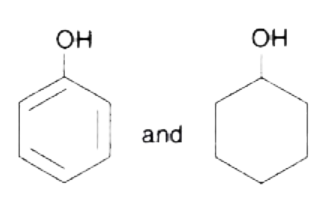Give chemical test to distinguish between the following pair of compounds: Benzyl chloride and chlorobenzene.
To distinguish between benzyl chloride (C6H5CH2Cl) and chlorobenzene (C6H5Cl), we can perform a chemical test using sodium hydroxide (NaOH) followed by silver nitrate (AgNO3). Here’s a step-by-step solution:
Step 1: Reaction with Sodium Hydroxide (NaOH)
- Procedure: Add a few drops of sodium hydroxide solution to a sample of the compound.
- Expected Outcome:
- Benzyl Chloride: Benzyl chloride will react with NaOH. The hydroxide ion (OH-) acts as a nucleophile and replaces the chlorine atom, forming benzyl alcohol (C6H5CH2OH) and sodium chloride (NaCl).
- Chlorobenzene: Chlorobenzene does not react with NaOH under normal conditions because the chlorine atom is attached to the aromatic ring, making it very stable and resistant to nucleophilic substitution.
Step 2: Reaction with Silver Nitrate (AgNO3)
- Procedure: After the reaction with NaOH, add silver nitrate solution to the mixture.
- Expected Outcome:
- Benzyl Chloride: The sodium chloride (NaCl) formed in the first step will react with AgNO3 to produce a white precipitate of silver chloride (AgCl).
- Chlorobenzene: No precipitate will form because chlorobenzene did not react with NaOH, and thus no NaCl is present to react with AgNO3.
Conclusion
- Observation:
- If a white precipitate of AgCl forms, the compound is benzyl chloride.
- If no precipitate forms, the compound is chlorobenzene.
Summary of the Test
1. Add NaOH:
- Benzyl chloride reacts to form benzyl alcohol and NaCl.
- Chlorobenzene does not react.
2. Add AgNO3:
- White precipitate (AgCl) indicates benzyl chloride.
- No precipitate indicates chlorobenzene.
- Procedure: Add a few drops of sodium hydroxide solution to a sample of the compound.
- Expected Outcome:
- Benzyl Chloride: Benzyl chloride will react with NaOH. The hydroxide ion (OH-) acts as a nucleophile and replaces the chlorine atom, forming benzyl alcohol (C6H5CH2OH) and sodium chloride (NaCl).
- Chlorobenzene: Chlorobenzene does not react with NaOH under normal conditions because the chlorine atom is attached to the aromatic ring, making it very stable and resistant to nucleophilic substitution.
- Procedure: After the reaction with NaOH, add silver nitrate solution to the mixture.
- Expected Outcome:
- Benzyl Chloride: The sodium chloride (NaCl) formed in the first step will react with AgNO3 to produce a white precipitate of silver chloride (AgCl).
- Chlorobenzene: No precipitate will form because chlorobenzene did not react with NaOH, and thus no NaCl is present to react with AgNO3.
- Observation:
- If a white precipitate of AgCl forms, the compound is benzyl chloride.
- If no precipitate forms, the compound is chlorobenzene.
1. Add NaOH:
- Benzyl chloride reacts to form benzyl alcohol and NaCl.
- Chlorobenzene does not react.
2. Add AgNO3:
- White precipitate (AgCl) indicates benzyl chloride.
- No precipitate indicates chlorobenzene.
Topper's Solved these Questions
Similar Questions
Give a chemical test to distinguish between the following pairs of compounds:
 View Solution
View SolutionGive any chemical test to distinguish between the following pair of compounds : acetine and phenol.
View SolutionGive a chemical test to distinguish between the following pairs of compounds:
Ammonium chloride and sodium chloride.View SolutionGive a chemical test to distinguish between the following pairs of compounds:
Hydrogen chloride gas and hydrogen sulphide gas.View SolutionGive a chemical test to distinguish between the following pairs of compounds:
Zinc and zinc oxide.View SolutionGive chemical tests to distinguish between the following pairs of compounds :
Benzaldehyde and benzoic acid.View SolutionGive a chemical test to distinguish between the following pairs of compounds: carbon dioxide gas and hydrogen chloride gas.
View SolutionGive chemical tests to distinguish between the following pairs of compounds :
Propanal and propanone.View SolutionWrite chemical tests to distinguish between the following pairs of compounds :
Acetophenone and benzophenone.View SolutionGive one chemical test to distinguish between the following pairs of compounds :
Phenol and benzoic acid.View Solution

